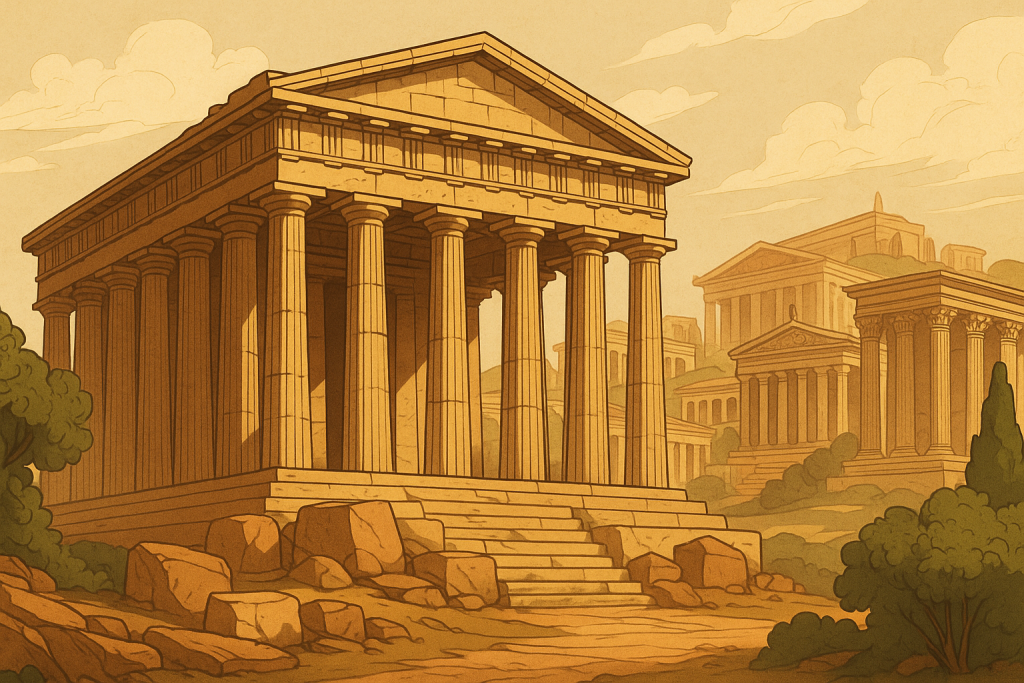Ancient structures like the Parthenon weren’t just made to last—they were made with purpose, symmetry, and stunning visual impact. Today, designers and urban planners are taking a serious second look at Ancient Greek Architecture and Design—and for good reason.

The Lasting Blueprint: Why Ancient Greek Architecture Still Matters
Modern cities may look futuristic, but their bones are ancient. A growing trend among architects and urban designers is drawing inspiration from Ancient Greek Architecture and Design, especially its clean lines, balance, and cultural storytelling. The principles established thousands of years ago continue to show up in everything from government buildings to luxury home façades.
In fact, a recent architectural review by the American Institute of Architects (AIA) emphasized how current urban planning projects are increasingly modeled after ancient Greek agora concepts, prioritizing public engagement and walkable city centers (AIA 2023).
The Core Principles of Ancient Greek Architecture and Design
When we talk about Greek architecture, we’re really talking about an entire design philosophy. Here are the foundational elements:
1. Symmetry and Proportion
The Greeks were obsessed with mathematical balance. The golden ratio—a concept found in the Parthenon—has resurfaced as a go-to tool for modern designers seeking visual harmony (Livio 2003).
2. The Classical Orders
The Doric, Ionic, and Corinthian columns aren’t just aesthetic—they’re functionally strategic. Each order tells a story and serves a structural purpose, principles echoed today in both commercial and residential architecture.
3. Purposeful Public Space
Ancient Greek Architecture and Design emphasized community interaction. Agoras were central open spaces meant for markets, politics, and socializing. Fast-forward to today, and you’ll see these ideas revived in urban designs that prioritize plazas, co-working spaces, and green rooftops.
Reviving the Past: How Modern Design Mirrors the Ancient World
Architecture today is about more than just looks—it’s about experience and usability. And that’s where Ancient Greek Architecture and Design continues to shine.
Neoclassical Revival in Urban Planning
Take a walk around Washington D.C., or even parts of Berlin, and you’ll see a strong influence of Ancient Greek structures in modern buildings. From clean porticos to symmetrical layouts, Greek ideals are baked into the DNA of democratic architecture. According to the British School at Athens, architects during the American founding era used Greek styles deliberately to represent power and civility (Jenkins 2018).
Sustainable Building the Greek Way
Surprisingly, ancient Greeks also pioneered passive solar design. Homes were built facing south to maximize sunlight and natural heating. Modern sustainable architecture is revisiting these ancient techniques to reduce energy consumption. Companies like BIG Architects in Denmark have implemented these passive designs in futuristic projects like the Amager Resource Center, showcasing how these old methods still work.
Ancient Greek Architecture and Design in 21st Century Homes
You don’t need to build a temple to bring classical design into your home. Here’s how the everyday homeowner is using these ancient principles today:
- Columns Reimagined: Load-bearing pillars that echo Doric or Ionic styles are common in luxury home designs.
- Open-Air Courtyards: Inspired by Greek atriums, these are now a must-have in upscale renovations.
- Natural Light Usage: Floor plans that prioritize sunlight, ventilation, and open space mimic Greek layouts.
These features don’t just add beauty—they increase property value. Real estate experts note that homes incorporating classical design elements sell for up to 18% more than standard builds (Zillow Research 2022).
From Past to Present: Key Lessons from Ancient Greek Architecture and Design
So what can you, a designer, homeowner, or city planner, actually take from Ancient Greek Architecture and Design?
1. Design with Purpose
Every column, every beam in ancient structures had a reason for existing. No wasted space, no empty gestures. Adopt this mindset in modern projects to create buildings that are both beautiful and highly functional.
2. Think Communally
Greek agoras promoted civic life. Design your spaces—homes, offices, parks—to encourage human interaction.
3. Value Simplicity Over Excess
The minimalism movement owes a debt to ancient Greece. Simple lines, open spaces, and natural elements create timeless appeal.
4. Prioritize Sustainability
The Greeks didn’t have air conditioning—they had architectural intelligence. Think passive solar, smart orientation, and sustainable materials.
Emerging Trend: Virtual Reconstructions of Ancient Greek Design
As tech meets tradition, archaeologists and designers are collaborating on 3D reconstructions of ancient Greek sites. These models, powered by tools like Unreal Engine and Blender, are used for academic research but also influence modern digital and physical design projects.
For example, the University of Oxford recently unveiled a virtual Parthenon experience that architects can walk through using VR headsets to study scale, proportion, and spatial acoustics (University of Oxford 2024). Expect to see more of these integrations as design goes increasingly digital.
Conclusion: Why the Future of Design Looks Ancient
It turns out the future of architecture isn’t futuristic—it’s ancient. By revisiting the wisdom of the past, today’s architects are building a better future, one that balances beauty, utility, and sustainability. Ancient Greek Architecture and Design is more than a history lesson; it’s a blueprint for modern living.
Whether you’re designing a skyscraper, remodeling your kitchen, or planning a city park, the principles laid down over 2,000 years ago are still your best guide.
References:
- Livio, M. (2003). The Golden Ratio: The Story of Phi, the World’s Most Astonishing Number. New York: Broadway Books.
- Jenkins, I. (2018). The Parthenon and its Sculptures. British Museum Press. Available at: https://www.bsa.ac.uk
- American Institute of Architects (2023). Urban Planning Trends. Available at: https://www.aia.org/resources/6477492-2023-urban-design-report
- University of Oxford (2024). Virtual Parthenon Initiative. Available at: https://www.ox.ac.uk/virtual-parthenon
- Zillow Research (2022). Home Design Trends That Add Value. Available at: https://www.zillow.com/research/design-value-report-2022-31275/









